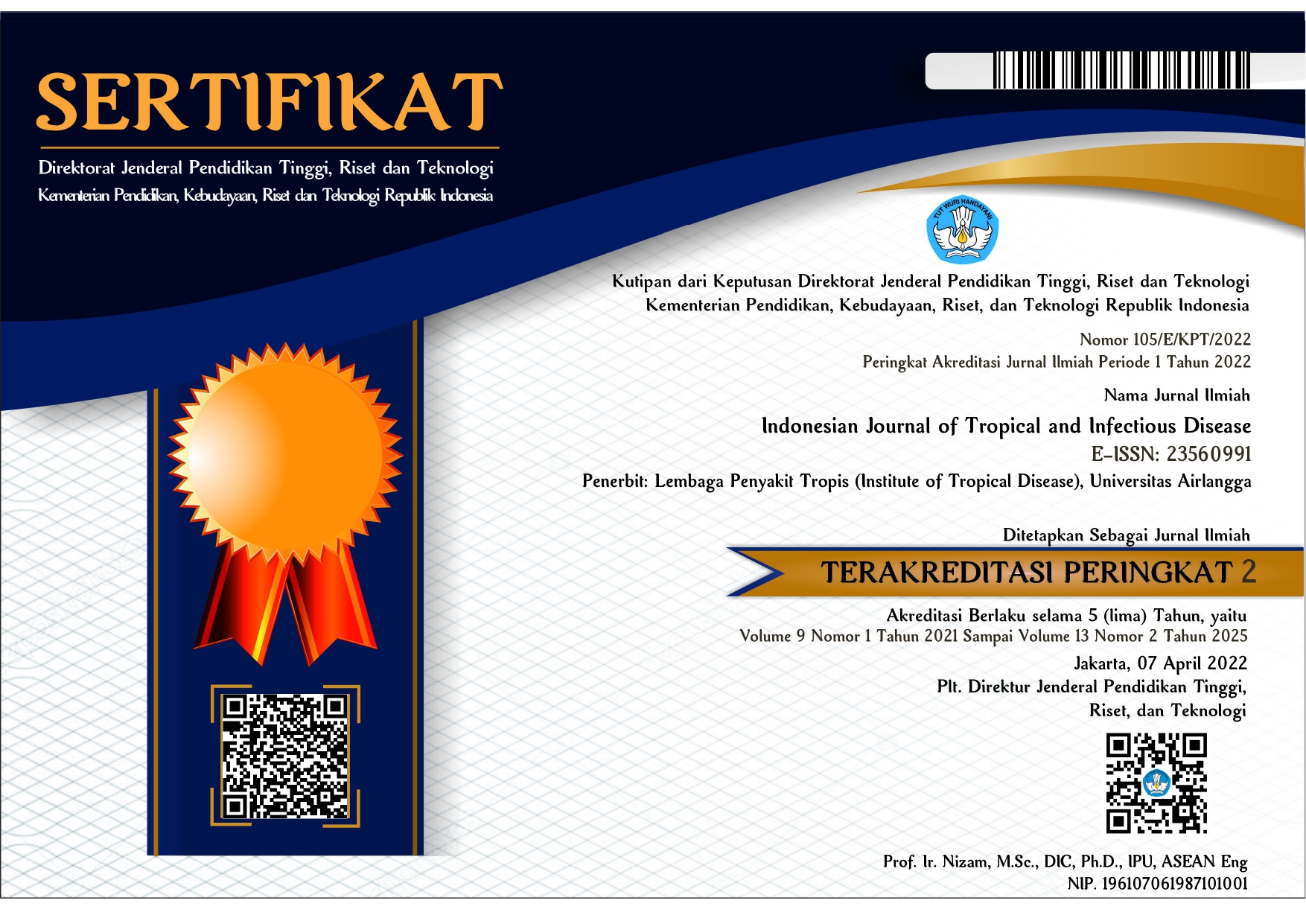In Vitro Analysis of SARS-CoV-2 Variants that Caused Severe COVID-19 in the Elderly
Downloads
Severe acute respiratory syndrome coronavirus 2 (SARS-CoV-2) caused the global problem of respiratory disease from 2019 to 2024. One of the earliest variations in the SARS-CoV-2 S protein was the S D614G mutation. SARS-CoV-2 has several important variants, namely, Alpha, Beta, Gamma, Delta, and Omicron. Omicron is the variant that has caused severe health problems, some
resulting in death, in the elderly. Omicron has further differentiated to some wellknown variants, such as, BA.1, BA.2, BA.2.75, BA.5, BQ.1.1, and XBB.1. According to Japanese Government data, the number of citizens aged 65 years old and above reached 28.9% in 2021. From our previous experiment, antibodies of the elderly that have received four doses of mRNA vaccine still could not optimally neutralize Omicron BQ.1.1 and XBB.1. We aimed to analyze the plaque size of SARS-CoV-2 variants that caused severe COVID-19 in the elderly. SARS-CoV-2 variants were seeded in Vero E6-TMPRSS2 cell culture to create plaques. The resulting plaques were analyzed with ImageJ application to select solitary plaques and to determine plaque sizes. The size of BA.1 plaque was indifferent to BA.2 plaque. The plaque area comparison result was as follows, BA.1/BA.2<BA.5<BA.2.75<BQ.1.1<XBB.1. The plaque sizes of Omicron BQ.1.1 and XBB.1 were bigger that those of Omicron BA.1 and BA.2. The plaque sizes of all Omicron variants were smaller than those of the previous
variants, S D614G and Delta. The result of this in vitro experiment inferred that there is increase in fusogenicity of BQ.1.1 and XBB.1, when compared with BA.1 and BA.2.
World Health Organization (WHO). Timeline: WHO’s COVID-19 response. 2023 [cited 2023 Dec 2]. Available from: https://www.who.int/emergencies/diseases/novel-coronavirus-2019/interactive-timeline
World Health Organization (WHO). Tracking SARS-CoV-2 variants. 2023 [cited 2023 Dec 2]. Available from: https://www.who.int/activities/tracking-SARS-CoV-2-variants
Ministry of Health, Labour and Welfare Japan. Visualizing the data: information on COVID-19 infections. 2022 [cited 2023 Dec 2]. Available from: https://covid19.mhlw.go.jp/en/
Auvigne V, Vaux S, Strat YL, Schaeffer J, Fournier L, Tamandjou C, et al. Severe hospital events following symptomatic infection with Sars-CoV-2 Omicron and Delta variants in France, December 2021-January 2022: A retrospective, population-based, matched cohort study. EClinicalMedicine. 2022 Jun;48:101455.
Statistics Bureau Ministry of Internal Affairs and Communications Japan. Statistical Handbook of Japan 2019. 2019 [cited 2023 Dec 2]. Available from: https://www.stat.go.jp/english/data/handbook/index.html
Sutandhio S, Furukawa K, Kurahashi Y, Marini MI, Effendi GB, Hasegawa N, et al. Fourth mRNA vaccination increases cross-neutralizing antibody titers against SARS-CoV-2 variants, including BQ.1.1 and XBB, in a very elderly population. J Infect Public Health. 2023 Jul;16(7):1064-72.
Chen C, Fan W, Li J, Zheng W, Zhang S, Yang L, et al. A promising IFN-deficient system to manufacture IFN-sensitive influenza vaccine virus. Front Cell Infect Microbiol. 2018 May 1;8:127.
Howley PM, Knipe DM, editors. Fields Virology. 7th ed. Vol. 3-RNA Viruses. United States of America: Wolters Kluwer; 2023.
Planas D, Bruel T, Staropoli I, Guivel-Benhassine F, Porrot F, Maes P, et al. Resistance of Omicron subvariants BA.2.75.2, BA.4.6, and BQ.1.1 to neutralizing antibodies. Nat Commun. 2023 Feb;14:824.
Saito A, Irie T, Suzuki R, Maemura T, Nasser H, Uriu K, et al. Enhanced fusogenicity and pathogenicity of SARS-CoV-2 Delta P681R mutation. Nature. 2022 Feb 10;602:300-6.
Meng B, Datir R, Choi J; CITIID-NIHR Bioresource COVID-19 Collaboration; Bradley JR, Smith KGC, Lee JH, Gupta RK. SARS-CoV-2 spike N-terminal domain modulates TMPRSS2-dependent viral entry and fusogenicity. Cell Rep. 2022 Aug 16;40(7):111220.
Qu P, Evans JP, Kurhade C, Zeng C, Zheng YM, Xu K, et al. Determinants and mechanisms of the low fusogenicity and high dependence on endosomal entry of omicron subvariants. mBio. 2023 Feb 28;14(1):e0317622.
Qu P, Evans JP, Faraone JN, Zheng YM, Carlin C, Anghelina M, et al. Enhanced neutralization resistance of SARS-CoV-2 Omicron subvariants BQ.1, BQ.1.1, BA.4.6, BF.7, and BA.2.75.2. Cell Host Microbe. 2023 Jan 11;31(1):9-17.e3.
Qu P, Evans JP, Faraone J, Zheng YM, Carlin C, Anghelina M, et al. Distinct neutralizing antibody escape of SARS-CoV-2 omicron subvariants BQ.1, BQ.1.1, BA.4.6, BF.7 and BA.2.75.2. bioRxiv [Preprint]. 2022 Oct 20:2022.10.19.512891.
Tamura T, Ito J, Uriu K, Zahradnik J, Kida I, Anraku Y, et al. Virological characteristics of the SARS-CoV-2 XBB variant derived from recombination of two Omicron subvariants. Nat Commun. 2023 May 16;14(1):2800.
Li X, Yuan H, Li X, Wang H. Spike protein mediated membrane fusion during SARS-CoV-2 infection. J Med Virol. 2023 Jan;95(1):e28212.
Chen DY, Chin CV, Kenney D, Tavares AH, Khan N, Conway HL, et al. Spike and nsp6 are key determinants of SARS-CoV-2 Omicron BA.1 attenuation. Nature. 2023 Mar;615(7950):143-50.
Yamasoba D, Kimura I, Nasser H, Morioka Y, Nao N, Ito J, et al. Virological characteristics of the SARS-CoV-2 Omicron BA.2 spike. Cell. 2022 Jun 9;185(12):2103-2115.e19.
Suzuki R, Yamasoba D, Kimura I, Wang L, Kishimoto M, Ito J, et al. Attenuated fusogenicity and pathogenicity of SARS-CoV-2 Omicron variant. Nature. 2022 Mar;603(7902):700-5.
Kimura I, Yamasoba D, Tamura T, Nao N, Suzuki T, Oda Y, et al. Virological characteristics of the SARS-CoV-2 Omicron BA.2 subvariants, including BA.4 and BA.5. Cell. 2022 Oct 13;185(21):3992-4007.
Saito A, Tamura T, Zahradnik J, Deguchi S, Tabata K, Anraku Y, et al. Virological characteristics of the SARS-CoV-2 Omicron BA.2.75 variant. Cell Host Microbe. 2022 Nov 9;30(11):1540-155.e15.
Govorkova EA, Murti G, Meignier B, de Taisne C, Webster RG. African green monkey kidney (Vero) cells provide an alternative host cell system for influenza A and B viruses. J Virol. 1996 Aug;70(8):5519-24.
Zaki AM, van Boheemen S, Bestebroer TM, Osterhaus AD, Fouchier RA. Isolation of a novel coronavirus from a man with pneumonia in Saudi Arabia. N Engl J Med. 2012 Nov 8;367(19):1814-20.
Osada N, Kohara A, Yamaji T, Hirayama N, Kasai F, Sekizuka T, et al. The Genome Landscape of the African Green Monkey Kidney-Derived Vero Cell Line. DNA Res. 2014 Sep 28;21(6):673-83.
Finelli P, Stanyon R, Plesker R, Ferguson-Smith MA, O’Brien PC, Wienberg J. Reciprocal chromosome painting shows that the great difference in diploid number between human and African green monkey is mostly due to non-Robertsonian fissions. Mamm. Genome. 1999;10:713-8.
Copyright (c) 2025 Indonesian Journal of Tropical and Infectious Disease

This work is licensed under a Creative Commons Attribution-NonCommercial-ShareAlike 4.0 International License.
The Indonesian Journal of Tropical and Infectious Disease (IJTID) is a scientific peer-reviewed journal freely available to be accessed, downloaded, and used for research. All articles published in the IJTID are licensed under the Creative Commons Attribution-NonCommercial-ShareAlike 4.0 International License, which is under the following terms:
Attribution ” You must give appropriate credit, link to the license, and indicate if changes were made. You may do so reasonably, but not in any way that suggests the licensor endorses you or your use.
NonCommercial ” You may not use the material for commercial purposes.
ShareAlike ” If you remix, transform, or build upon the material, you must distribute your contributions under the same license as the original.
No additional restrictions ” You may not apply legal terms or technological measures that legally restrict others from doing anything the license permits.























